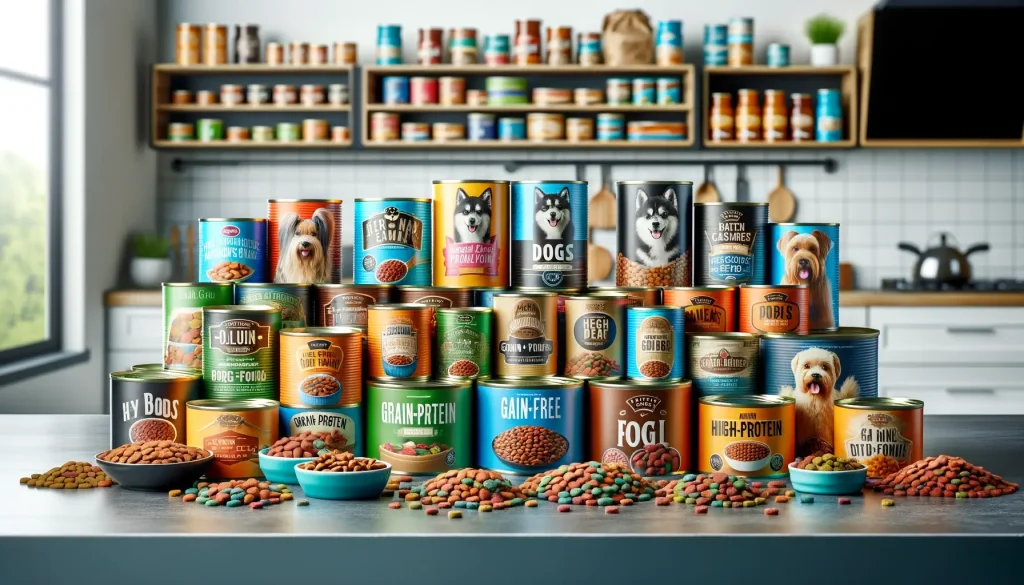
As a dedicated pet owner, understanding what goes into your dog’s food is crucial for their health and wellbeing. Among various ingredients, xanthan gum often pops up, especially in canned dog foods. Originating from the fermentation of the bacterium Xanthomonas campestris, this white powder serves as a thickener and stabilizer. Despite its benefits in improving food texture and shelf life, its status as a manufactured additive raises questions about its safety and naturalness for our canine companions.
With its roots in natural fermentation yet a final form that’s undeniably processed, xanthan gum stands at the crossroads of natural and synthetic. It’s approved by the American Food and Drug Administration (FDA) for use in both human and pet foods, hinting at its general safety. Nevertheless, for dogs with sensitive systems, it’s noted that xanthan gum might lead to digestive discomforts like loose stools on rare occasions.
The controversy around its use and the quest for the best nutrition for our pets lead us to question: How can pet owners navigate the inclusion of xanthan gum in their dog’s diet responsibly?
Monitoring Xanthan Gum in Your Dog’s Diet at Home
Knowing if xanthan gum is safe for your dog involves more than just reading labels. At home, you can take steps to ensure that your dog’s diet, including any foods containing xanthan gum, supports their health. Here are tangible actions you can do:
- Read Labels Carefully: Always check the ingredients list on dog food packaging. Look for xanthan gum and be aware of its presence. Knowledge is power.
- Start Slowly: If introducing a new food that contains xanthan gum, do it gradually. Mix it with their current food and observe any changes in their digestion or stool.
- Watch for Allergies: Since xanthan gum is often made from corn or wheat, dogs with allergies to these grains should be monitored closely. Any sign of an allergic reaction should be noted.
- Notice Digestive Changes: Be observant of your dog’s bowel movements. Loose stools or signs of digestive discomfort after eating foods with xanthan gum might indicate sensitivity.
- Consult Your Vet: Before making any significant diet changes or if you notice any adverse reactions, talk to your veterinarian. They can provide personalized advice based on your dog’s health history.
Ensuring the well-being of your pet means being proactive about what goes into their body. By following these simple steps at home, you can make informed decisions about feeding your dog foods that contain xanthan gum. Each dog is different, and what works for one, might not work for another. The key is to balance the benefits of dietary additives like xanthan gum with vigilant observation and professional advice.


Choosing the Right Dog Food with Xanthan Gum
Finding the perfect dog food for your pet involves more than just recognizing xanthan gum on the label. Since xanthan gum is generally safe for dogs, the focus shifts to overall nutrition and compatibility with your dog’s health needs. Here are some steps to choose the right food:
- Analyze Overall Ingredients: Don’t just spot check for xanthan gum. Look at the entire ingredients list. Aim for foods with high-quality protein sources and minimal fillers.
- Consider Your Dog’s Age and Activity Level: Puppies, adult dogs, and seniors have different nutritional requirements. So do active dogs compared to more sedentary ones. Select a food that matches their life stage and lifestyle.
- Keep an Eye on Allergens: Given that xanthan gum can be derived from common allergens like corn or wheat, ensure there are no other ingredients that could trigger an allergic reaction in your dog.
- Transition Slowly: When switching to a new dog food, especially one containing xanthan gum, introduce it gradually over several days to monitor for any adverse reactions.
- Seek Vet Advisement: Always consider your veterinarian’s recommendations, especially if your dog has specific health conditions or dietary needs.
Ultimately, the goal is to provide a balanced diet that supports your dog’s health and wellbeing. By being mindful of xanthan gum and other ingredients in dog food, you can make informed choices that contribute to your dog’s long-term health. Remember, each dog is unique, so what works well for one dog may not be suitable for another.
When to See the Vet for Xanthan Gum Worries
As a pet owner, it’s essential to know when to seek professional help regarding your dog’s diet, especially if it includes foods containing xanthan gum. Even though xanthan gum is generally safe, each dog reacts differently to different ingredients. Here’s when you should consider a vet visit:
- Noticeable Digestive Issues: If your dog exhibits loose stools or other signs of digestive discomfort after eating foods with xanthan gum, it’s time to check in with a vet.
- Allergic Reactions: Since xanthan gum can be derived from corn or wheat, dogs with allergies to these grains may react. Any skin rash, itching, or unusual symptoms should prompt a vet visit.
- Change in Appetite: A sudden disinterest in food or decrease in appetite, especially if you’ve recently introduced foods containing xanthan gum, warrants a professional opinion.
- Chronic Health Conditions: Dogs with existing digestive issues or chronic health conditions should have their diet supervised by a vet, particularly when introducing new ingredients like xanthan gum.
Consulting with your veterinarian is a proactive step in ensuring your dog’s health and wellbeing. They can offer guidance tailored to your dog’s specific needs and conditions. Remember, while xanthan gum is approved by the FDA and considered safe, monitoring your pet and seeking expert advice is always beneficial.

Tips for Healthy Digestion in Dogs
Ensuring healthy digestion in dogs is a priority for pet owners, especially when incorporating ingredients like xanthan gum into their diets. The quest for optimal canine health doesn’t stop at the ingredient list; it extends into every aspect of their dietary habits. Here, we explore essential tips that can help maintain your dog’s digestive health, focusing on practical steps and keen observation.
- Monitor Feeding Habits: Keep a close eye on how your dog eats. Rapid eating can lead to digestive issues, so consider using slow-feed bowls to pace their intake. Hydration is equally important, as sufficient water intake supports the digestive process and helps prevent constipation.
- Regular Exercise: Physical activity isn’t just good for your dog’s overall health; it’s also crucial for stimulating digestion. Regular walks and playtime can help keep their system moving and reduce the chances of digestive blockages.
- High-Quality Diet: Beyond xanthan gum, the quality of all ingredients in your dog’s food matters. Opt for diets rich in fiber, quality proteins, and essential nutrients to support gut health. Avoid overly processed foods and those with high amounts of fillers and artificial additives.
- Dietary Consistency: Sudden changes in diet can upset your dog’s digestive system. When introducing new foods or transitioning between brands, do so gradually to allow your dog’s system to adjust.
- Recognize the Signs of Digestive Distress: Be vigilant about symptoms such as vomiting, diarrhea, excessive gas, or lethargy, as these can indicate digestive issues. Early detection and response can prevent more serious health problems.
- Regular Veterinary Check-Ups: Routine vet visits are vital for monitoring your dog’s health, including their digestive system. Discuss your dog’s diet, including the use of xanthan gum and other ingredients, to get professional advice tailored to your pet’s specific needs.
By focusing on these top tips for healthy digestion, pet owners can ensure their dogs not only enjoy their meals but also benefit from a well-functioning digestive system. This proactive approach to canine health helps mitigate potential issues related to xanthan gum and other dietary components, ensuring a happy, healthy life for your furry friend.

Nutrition and Ingredients in Your Dog’s Diet
Creating a balanced diet for your dog goes beyond the inclusion or exclusion of a single ingredient like xanthan gum. A holistic approach to canine nutrition involves understanding the interplay between various components of their food and how it impacts overall health. In this section, we delve into strategies for balancing nutrition with the careful selection of ingredients, ensuring your dog receives all the necessary nutrients for a healthy life.
- Understand Nutritional Needs: Each dog has unique nutritional requirements based on age, breed, activity level, and health status. Familiarize yourself with the basics of canine nutrition, including the need for proteins, fats, carbohydrates, vitamins, and minerals, to make informed choices about your dog’s diet.
- Quality Over Quantity: Select dog foods where high-quality ingredients are the priority. Foods that list real meats, vegetables, and wholesome grains (if tolerated) at the top of the ingredient list are generally preferable. Avoid products laden with by-products, artificial colors, and flavors, which can compromise nutritional quality.
- Diversity for Nutritional Coverage: Incorporating a variety of foods into your dog’s diet can help cover the spectrum of nutritional needs. For dogs without specific food sensitivities, rotating between different protein sources and formulations can provide a more comprehensive nutrient profile.
- Supplements When Necessary: Some dogs might need supplements to address specific health concerns or nutritional deficiencies. Fish oil, for example, can support skin and coat health, while probiotics may aid in digestion. Always consult with your veterinarian before adding supplements to your dog’s diet.
- Reading and Understanding Labels: Learning how to read pet food labels can empower you to make better dietary choices for your dog. Pay attention to the order of ingredients, the guaranteed analysis, and the nutritional adequacy statement to ensure the food meets your dog’s requirements.
- Consult with Professionals: A veterinarian or a canine nutritionist can provide personalized advice that considers your dog’s individual health and nutritional needs. They can also offer guidance on how to safely include foods containing xanthan gum and other additives.
By taking a comprehensive approach to your dog’s diet, you can balance the benefits and drawbacks of various ingredients, including xanthan gum. This ensures that your dog not only enjoys their meals but also thrives on a diet that supports their health and wellbeing in every stage of life. Remember, the goal is to nourish your dog with a well-rounded diet that promotes longevity and vitality, rooted in an understanding of their specific nutritional needs.
Beginner Guide to Raising Quail at Home
What are the Signs of a Dog Concussion?
What Causes Your Dog’s Ears to Smell Bad?
When your dog’s ears start to emit an unpleasant odor, it might leave you puzzled…
Methimazole Treatment for Cat Hyperthyroidism
Methimazole plays a crucial role in managing feline hyperthyroidism, a condition marked by an overactive…
Got Hummingbirds in your Backyard? Here’s How to Care for Them.
Why Does Your Cat Pee Outside the Litter Box?
Cat’s Litter Box Issues It’s not uncommon for cat owners to face the frustrating dilemma…




